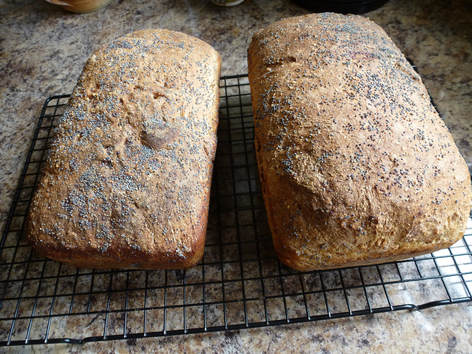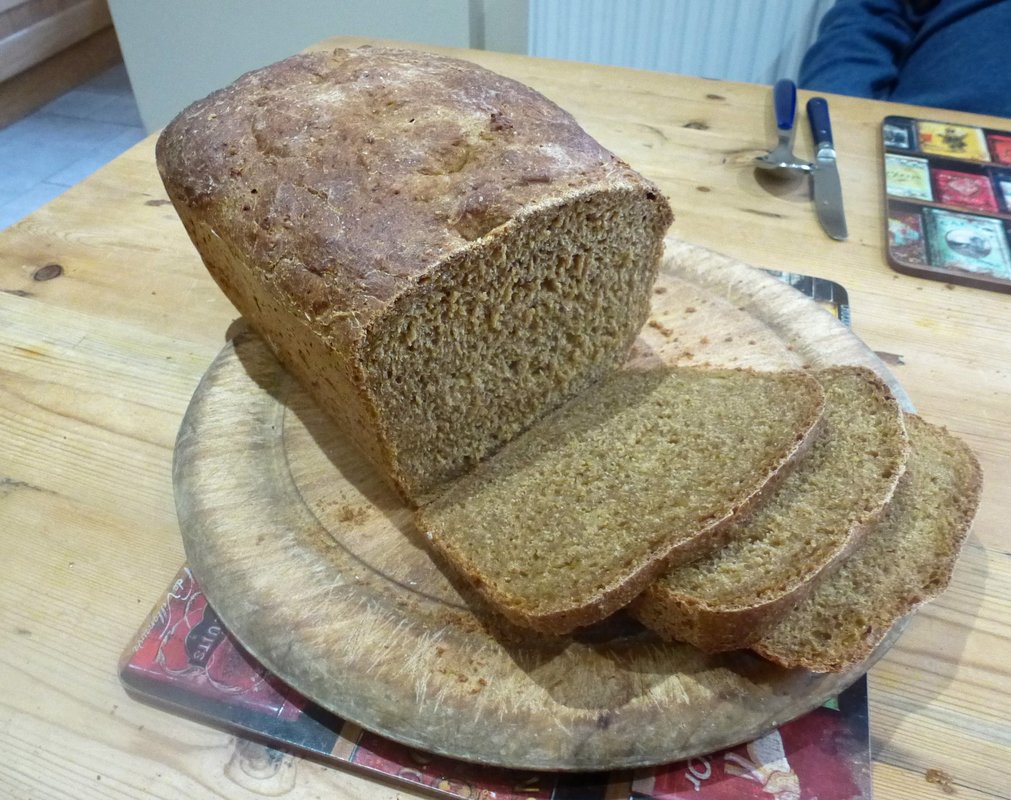Now that harvest time is here, I had an urge to bake Struan bread again. This is a bread whose history is rather vague, but the nicest description I’ve found is that it was traditionally made for the Feast of St Michael (Sep 29th) in Scotland and maybe Ireland too. The loaf should be made by the eldest daughter of the household, then carried into the church to be blessed, and set there in honour of relatives and friends who are no longer with us. Last year I made it with my eldest granddaughter.
I’ve adapted a recipe from http://www.thefreshloaf.com/recipes/struanbread. Its return to popularity was apparently started by Brother Juniper, a lay monk and star baker in California, and I’m looking forward to getting his cookbook, Brother Juniper Bread Book: Slow Rise as Method and Metaphor – I’ve ordered the original version from 1991. Sounds good for mindful baking!
Struan bread is a mix of harvest grains and flours. Now since this recipe has polenta, ie cornmeal, I doubt that this was what they used in the Outer Hebrides! But it goes with the spirit of the dough, and using what you have to hand at harvest-time. I’ve added in millet simply because it’s my favourite added grain at the moment – nice and crunchy.
I’ve added in metric measurements. It’s one of those recipes where you really do need to check it out as you go along, and see whether you need more flour or less water. So hold back on the water, add it a little at a time until you get the right consistency. My first go this year ended up much too sloppy and sticky and was a nightmare to manage! Although it turned out well in the end. Today’s was better-controlled. I currently use a Kitchen Aid to do the kneading, but kneading by hand would indeed be more mindful. If you do use a machine, check that it’s mixed properly early on in the process as there are a lot of different ingredients to blend.
Struan Bread Recipe
Makes 1 large loaf – double the quantity for 2, which means you’ll have one to freeze. Worthwhile, as it takes effort to assemble all the ingredients and time to prepare the dough.
Soaker
3 tablespoons polenta 30-40gm
3 tablespoons rolled oats 25 gm
2 tablespoons wheat bran 10gm
1/4 cup water 60ml
Dough
3 cups unbleached bread flour 380-400gm
(You can substitute up to 25% wholemeal if you wish)
3 tablespoons brown sugar
1.5 teaspoons salt
1 tablespoon instant yeast
3 tablespoons cooked brown rice 50gm
(Short grain is good but long grain is fine)
1.5 tablespoons honey
Half a cup buttermilk (130 ml, or use a little more and reduce water)
3/4 cup water 170ml – Add carefully; you probably won’t need it all
2 tbsp millet
Topping
1 tablespoon poppy seeds
(If you don’t have poppy seeds, use another seed like sunflower)
Mix together the ingredients for the soaker. Cover and allow to soak for at least half an hour or as long as overnight.
Method
In a large bowl, combine the dry ingredients, then stir in wet ingredients and soaker. Add more flour or water until the dough can be formed into a ball that is neither too dry nor too loose in texture. Try to keep it so that you can still handle the dough, even if it is a little sticky. I recommend leaving the millet out of the dough until you approach the end of the kneading process, but overall, knead the ball of dough for 10 to 12 minutes, (8-10 in a food processor with dough mixer). Return it to the bowl and cover with a damp tea towel until doubled in size, approximately 60 minutes.
Remove the dough from the bowl, knock it down briefly to take out the air, and put it into a greased bread pan. Sprinkle a little water on top, followed by a dusting of poppy seeds. Cover the dough in the pan loosely again and allow the loaves to rise until doubled in size again, approximately 40-60 minutes.
Bake these loaves at 180 C. (350+F) degrees for about 40-45 minutes. (I used a fan oven; you might need to use 190 in a non-fan one.) It will achieve a high bake colour so don’t be tempted to take it out too early. Test in the usual way, by tapping the bottom of the loaf when you think it’s ready to see if it sounds hollow.
Enjoy! As the website says, the aroma from this bread as it cooks is fantastic, and it makes ‘killer toast’.


 RSS Feed
RSS Feed